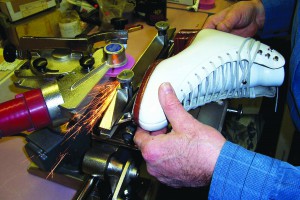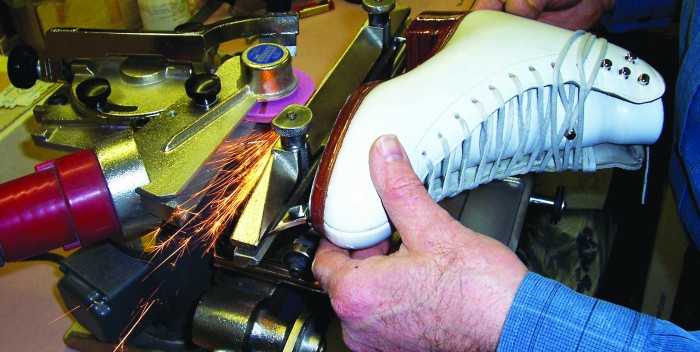Ask Mr. Edge – Breaking In New Skates

by John Harmata
This holiday season will be no different, as thousands of parents will once again buy their children new ice skates. Some kids will have no problem breaking in their new skates, while others may experience the pain and blistering that sometimes accompanies the initial break-in period.
Let us take a look at some unique ways in which people break in their new skates, and then we will review some common sense approaches to breaking in new skates.
Unique Practices for Breaking in New Boots
- Soak both boots in hot water for an hour or so before mounting the blades, then proceed to walk or skate in them while the boots are still wet. Note: Be aware that soaking boots for any amount of time in water will damage them, especially if nothing was done to seal the soles and heels before soaking.
- Heat boots in a home convection oven at 180 degrees for three to five minutes and wear them around the house. Note: Never use a conventional kitchen oven, because it applies direct heat to the boots and dries out the natural oils in them. A convection oven will circulate warm heat in and around the boots.
- Soak boots in ice water for an hour before skating.
- Spray boots with leather stretch prior to skating every time until boots are broken in.
- Rub interior of boots with a leather conditioner or softener, or with Vaseline.
- Place “animal fat” gel pads around your ankles.
- Use gel sleeves around both your heels and ankles.
- Wrap ankles with an ace bandage or gauze.
- Skate with plastic wrap or Reynolds turkey-size oven cooking bags wrapped around your feet.
- Soak lightweight socks in hot water and wear them while skating.
- Have someone else wear the boots first.
Common Sense Steps to Breaking in New Boots
Start by tying laces to the second hook, leaving the top hook untied. Note: Use all-nylon laces when breaking in new boots because they stretch more, making it easier to bend at the ankles.
- Switch over to cotton-nylon (50-50 blend laces) after a couple weeks.
- For the first hour, do crossovers and stroking.
- During the next two to three hours, begin mixing in spins.
- During hours four and five, lace boots to the top and begin jumping.
- During hours six and seven, increase jump and spin time.
- After seven hours of breaking-in time, resume a normal routine.
No matter which method a skater chooses to break in new boots, the first line of defense against injury is a correctly fitted boot. Proper alignment of the foot inside a good, but not overly supportive, boot also will help to prevent injury.

John Harmata, a.k.a. Mr. Edge, is a skate technician with more than 35 years of experience in servicing figure skaters throughout the United States, Canada and from overseas as well. Any questions may be addressed to him directly via email at: askmredge@aol.com. For more information, visit: askmredge.com.

 MY COACH ROCKS
MY COACH ROCKS TEAMS IN SYNC
TEAMS IN SYNC EXPRESS YOURSELF
EXPRESS YOURSELF FOCUS ON ARCHIVES
FOCUS ON ARCHIVES COMPETITORS’ CORNER
COMPETITORS’ CORNER NEWS & NOTES
NEWS & NOTES






